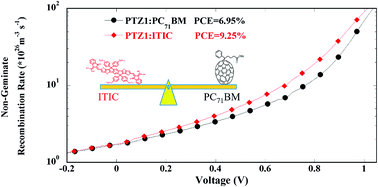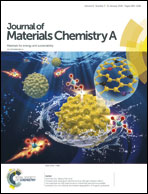Improved photocurrent and efficiency of non-fullerene organic solar cells despite higher charge recombination†
Abstract
Organic solar cells (OSCs) with a fused-ring dye, ITIC, and fullerene derivative PC71BM as the acceptor materials were fabricated. Compared to PC71BM-based cells, which reach a power conversion efficiency of 6.91%, the ITIC device shows a significantly higher power conversion efficiency (9.20%). The broader absorption range of ITIC helps to improve the short-circuit current density, which leads to better device efficiency. Electrical characterization, including electrical simulations and impedance analysis, was performed to investigate the physical processes in these OSCs. The results suggest that the charge-recombination loss in the non-fullerene device is even higher than that in PC71BM cells. Morphological analysis reveals that a poor phase-separation in the photoactive layer is responsible for the large recombination loss. Our results indicate that fused-ring acceptor materials are promising candidates for high-efficiency OSCs. Furthermore, if recombination loss could be suppressed effectively, the energy conversion efficiency of non-fullerene organic solar cells can be even higher.



 Please wait while we load your content...
Please wait while we load your content...